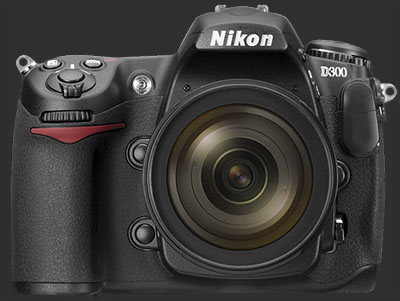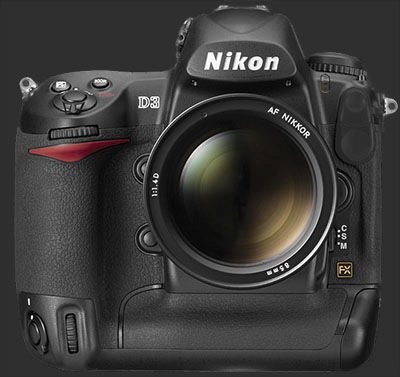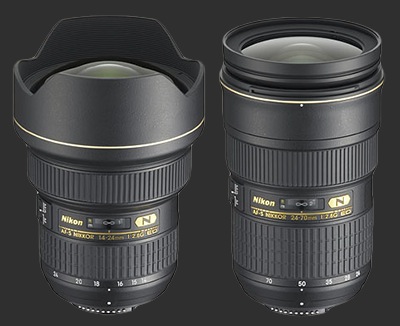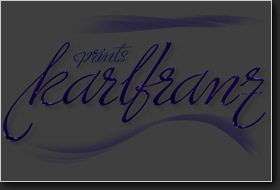Photography
prints karlfranz online store now open
09/20/2009 06:09 PM
karlfranz.com is proud to announce that its
online store prints karlfranz is
now open for business. In this store you will find
high-quality limited edition prints in a variety
of styles including acrylics, pen & ink, and
processed photography. These prints are unique,
beautiful and suitable for framing and display in
your home, office or den. Quantities of each print
are strictly controlled—once the edition runs out,
no further prints of that image will be made. Head
on over to our store at http://www.printskarlfranz.com or
click on the “Go to Online Store” link in the
menu to your right to check out our selection.
|
Nikon issues firmware update for D300
02/14/2008 10:34 PM

To confirm your cameras current firmware version, press the MENU button and select Firmware Version from the setup menu. The camera's firmware version will be displayed.
To download for Macintosh OS X, click here.
To download for Microsoft Windows, click here.
Nikon announces D3
08/23/2007 05:01 PM

“Nikon has eclipsed the competition with the D3, a cutting edge camera that will change how professional photographers take pictures,” said Robert Cristina, Brand Manager, Nikon Professional Products, Europe. “The incredible speed, resolution and flexibility of the D3 will enable photographers to capture images under conditions previously thought impossible.”
The D3, the result of years of development and feedback from professional photographers, combines many innovative Nikon technologies. These include an exclusive 12.1 effective megapixel FX format (36.0x23.9mm) image sensor with 12-channel read out, a blazing-fast 9 fps frame rate, expandable ISO settings from 200-6400, a completely new 51-Point autofocus system, a 3-inch VGA LCD screen with Live View and a cutting-edge image processing system.
FX Format Image Sensor
The D3 FX format CMOS imaging sensor was designed from the ground up to offer exceptional light transmission properties, so photographers can acquire outstanding image quality even in low light conditions. With a high signal to noise ratio, a pixel pitch 15% larger than competitive cameras, gapless surface micro-lenses and advanced on-chip noise reduction means high-quality images under very low light levels are now possible. The sensor enables an ISO settings range from 200-6400, expandable up to the equivalent of 25,600 or down to 100.
EXPEED Image Processing System
The EXPEED image processing system is at the heart of the D3’s ability to capture and process massive amounts of data at high definition. The EXPEED system includes both hardware and years of Nikon image processing experience. The D3 EXPEED system features 14-bit analog-to-digital (A/D) conversion with 16-bit image processing, both of which contribute to delivering results with Nikon’s signature ‘look and feel’ of rich accurate colours, smooth skin gradations and exceptional detail.
Scene Recognition System
The D3 features a radical new approach to calculating exposures and white balance with intelligent support for Autofocus tracking performance as well. At the heart of the Scene Recognition System is Nikon’s renowned 1005-pixel RGB metering sensor that has been modified to distinguish subjects’ shape and position for improved auto exposure and Autofocus accuracy.
Advanced Autofocus
Building on years of development through both the analogue and digital SLR era, Nikon has once again raised the bar for optical Autofocus systems. The D3 and D300 feature a completely new 51-Point autofocus system designed to acquire and track subjects’ movement more accurately.
The result of intensive studies into how professional sports and news photographers use autofocus, the Multi-CAM3500 AF module features the most AF points ever developed for a SLR camera. The inspired coupling of the AF module with Nikon’s easy-to-use 8-direction multi selector button makes selecting instant individual AF points simple and fast. As one would expect the AF system can be completely customised for every possible shooting condition.
Scorching Speed, Intuitive Response
The image quality of the D3 is combined with outstanding frame rate options. At 9 fps, the D3 is the world’s fastest full format D-SLR1, with an even faster 11fps2 consecutive shooting possible in DX crop mode. A second crop mode is also premiered in the D3, with 5:4 (30mm x 24mm) aspect ratio. Shutter release time lag is an imperceptible 41 milliseconds (CIPA standard), while the image sensor’s integrated high-speed 12-channel readout contributes both to burst speed and Live View performance. The D3 also gets to work quickly; startup time is just 0.12 seconds and mirror black out is only 74ms.
Shutter Unit
The D3 incorporates an all-new Nikon manufactured shutter unit tested to over 300,000 cycles. The shutter blades are constructed from a durable composite KevlarTM and carbon fibre material to deliver unmatched durability and accuracy even in the most demanding of conditions.
Picture Control
Nikon’s new Picture Control system, developed with the help of extensive feedback from photographers, offers improved productivity for JPEG shooters. Picture Control lets users of all levels manage and customise the appearance of their images in camera. This on-board processing saves significant post processing time. With a variety of default settings, photographers can also customize and share settings. Nikon anticipates photographic communities might develop their own Picture Control settings for specific subjects and conditions. Picture Control replaces the existing Colour Mode settings of current Nikon cameras.
High Contrast Subjects, Low Risk
The Active D-Lighting feature of the D3 adds to its JPEG capabilities. Prior to shooting under high contrast conditions, users can apply a pre-set curve that processes images with improved shadow and highlight details, without affecting overall contrast.
Designed for definition
Everything about the D3 is high definition. From the HDMI (High Definition Multimedia Interface) port for output to the latest HD displays to the 3-inch VGA LCD screen with 170-degree viewing angle, images can be played back at very high levels of detail. The new VGA screen also comes into its own when using the new Live View function premiered in the D3 and D300. Unlike other live view technologies, autofocus in possible in all Nikon Live View modes.
Flexible Image Storage
The D3 is the world’s first D-SLR to offer dual CompactFlash card slots for outstanding storage flexibility. A photographer can shoot images to each card one after the other, or simultaneously, as back up. When shooting combined NEF and JPEG files, the NEF image can be written to one card and the JPEG version to the other. Image files can also be selected and copied from one card to the other after shooting.
One Tough Customer
Long the choice of professionals, Nikon SLRs are renowned for withstanding the most challenging conditions. From freezing temperatures of the arctic to the humidity of the rainforest, Nikon’s keep working long after other cameras have ceased to operate, and the D3 is built to continue this tradition. Magnesium alloy is used for the exterior cover, chassis and mirror box, while the seams and buttons of the camera body are sealed against the affects of dust and moisture.
Wireless Networking
Nikon pioneered wireless image transmission. Now, with the new Nikon Wireless Transmitter WT-43, the era of the multi camera network has arrived. Not only can one transmit images to servers and remotely control the camera from afar, the WT-4 also enables remote browsing of the camera’s image thumbnails as well.
In a wireless environment, networks of up to 5 D3 and D300 cameras can be established. At a sports event, for example, photo editors could browse all thumbnails on each camera simultaneously, selecting the images they need, while the photographers continue shooting.
The D3 body measures 159.5 (W) ×157 (H) ×87 (D) mm and weighs 1,390 grams including battery. It will be available in Europe from November 2007.
Nikon announces D300
08/23/2007 05:01 PM

“Packed with the latest technologies and Nikon’s renowned ergonomics, the D300 sets a new standard for professionals on a budget,” said Robert Cristina, Brand Manager, Nikon Professional Products, Europe. “The D300 is a true ‘go-anywhere’ camera, delivering fast response, high performance and ease of use that will appeal to anyone serious about their photography.”
Speed and Performance
The D300 is loaded with the latest professional technologies designed to produce images of the highest quality. The high-resolution 12.3 MP DX format CMOS sensor generates image files suitable for almost every type of output, combined with a fast standard frame advance rate of 6fps (up to 8 fps with optional Multi Power Battery Pack). The D300 offers fast power-up, quick response and outstanding flexibility to meet the needs of a wide variety of photographic assignments. The D300 powers-up in just 0.13 seconds, with an almost imperceptible 45 millisecond shutter lag.
Accuracy
The D300 boasts a self-cleaning sensor unit, which vibrates at high frequencies to remove any loose dust on the surface of the sensor’s optical low pass filter. The camera has a broad ISO range from 200-3200 plus Lo 1 (the equivalent of an ISO 100) and Hi (ISO 6400 equivalent). Image accuracy is also enhanced by the new Nikon Scene Recognition System, which uses the acclaimed Nikon 1005-pixel RGB colour sensor modified to recognise subjects’ shape and position before the image is captured. This also aids the new 51-Point Autofocus system in tracking subjects by their colour, while enhancing the accuracy of exposure and white balance metering. The D300 also offers Live View, which presents photographers with a live image on the LCD screen, with two modes suited to either hand held or tripod shooting. Autofocus is possible in both Live View modes.
Enhanced Images with EXPEED
The EXPEED image processing system is at the heart of the D300’s ability to capture and process high definition image data so quickly. The EXPEED system includes both hardware and years of Nikon image processing expertise. The D300 EXPEED system features 14-bit analog-to-digital (A/D) conversion with 16-bit image processing, both of which contribute to delivering results with Nikon’s signature ‘look and feel’ of rich accurate colours, smooth skin gradations and exceptional detail.
Ready for tomorrow
The D300 is completely high definition. From the 3-inch VGA LCD screen with 170-degree viewing angle, to the HDMI interface for HD ready displays, the D300 is ready for tomorrow’s imaging environment. The controls of the D300 were designed for ease of use, with an easy-to-view top LCD panel and an information display on the rear LCD screen that can change colour according to the ambient lighting conditions.
The totally intuitive 8-directional multi-area selector makes selecting any of the 51-Point autofocus settings simplicity itself.
Durable and Dependable
The D300 continues Nikon’s long tradition of sturdiness and durability. The camera body is built from a magnesium alloy, while the camera’s shutter has been tested for 150,000-release cycles. The D300 is also designed for a high level of dust and water resistance.
Total Imaging System
Like the D3, the D300 isn’t just a camera, but part of a complete Nikon system to help photographers create great images. The D300 is compatible with the Nikon Total Imaging System of NIKKOR lenses, Speedlights, accessories and software that provides a complete solution for any photographic challenge.
One accessory that can extend shooting life, add ergonomic vertical shooting practicality and increase frame rate to up to 8 fps* is the MB-D10 optional Multi-Power Battery Pack. The compact MB-D10 simply attaches to the base of the camera. Unlike other grips, the MB-D10 does not occupy the camera’s battery space, so one can shoot with two EN-EL3e batteries, or add a powerful EN-EL4a battery into the mix. The D300 and MB-D10 can also be powered by AA size batteries as well. *Requires EN-EL4a.
Wireless Networking
Nikon pioneered wireless image transmission. Now, with the new Nikon Wireless Transmitter WT-43, the era of the multi camera network has arrived. Not only can one transmit images to servers and remotely control the camera from afar, the WT-4 also enables remote browsing of the camera’s image thumbnails as well. In a wireless environment, networks of up to 5 D300 cameras can be established and image thumbnails from all connected cameras browsed simultaneously and relevant image files pulled, while the photographers continue shooting.
The D300 body measures 147.2 (W) ×112.8 (H) × 74(D) mm and weighs just 795 grams.
Available in November 2007.
Nikon announces 2 new zoom lenses
08/23/2007 05:01 PM

“These new zoom NIKKORS offer photographers immense creative potential when combined with the new FX-format D3, but are equally useful for those using Nikon’s DX-format cameras too”, said Robert Cristina, Brand Manager, Nikon Professional Products Europe. “They are the first wide-angle lenses to incorporate Nikon’s unique Nano Crystal coat, that suppresses the ghost and flare that sometimes occurs with the reflective surfaces of digital sensors.”
AF-S NIKKOR 14-24mm f/2.8G ED
The ultra wide-angle/fast aperture combination of the AF-S 14-24mm f/2.8G ED lens is a world first*, and is highly adaptable for the tight spaces busy professional photographers often find themselves working in. The excellent optical quality of this 14-24mm lens, combined with excellent levels of detail contributes to brilliant, sharp results.
AF-S NIKKOR 24-70mm f/2.8G ED
The completely new standard zoom AF-S 24-70mm f/2.8G ED complements the NIKKOR range of professional lenses. Much slimmer than its predecessor, (the AF-S Zoom-Nikkor 28-70mm f/2.8) the new lens exhibits outstanding characteristics at wide settings where centre-to-peripheral resolution is a priority, making it ideal for landscape photography. At the 50-70mm setting, crisp details are displayed with excellent bokeh, making the lens highly suited for portraits.
Both lenses share Nikon’s unique Nano Crystal coat technology to minimize ghost and flare, with ED glass elements contributing to outstanding levels of resolution and contrast. Nikon’s precision Silent Wave Motor assures fast and quiet autofocus performance, with instant manual override possible. Both lenses are designed with high dust and moisture resistance, and include a rubber seal around the bayonet mount.
Specifications and Availability
- The AF-S 14-24mm f/2.8G ED measures 98×131.5mm and weighs approximately 1,000g.
- The AF-S 24-70mm f/2.8G ED measures 83×133mm and weighs approximately 900g.
- Each of the new lenses comes with a flower-shaped hood and a semi-soft case.
- The hood of the 14-24mm is integrated, the 24-70mm removable.
- Prices to be revealed in September.
- Both lenses will be available in November 2007.

